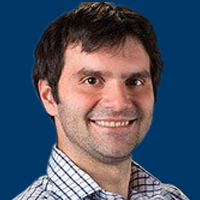Weber Highlights Potency of Adjuvant Nivolumab in Melanoma
Jeffrey S. Weber, MD, PhD, discusses the promise of nivolumab in this setting and a general overview of the melanoma treatment landscape.
Jeffrey Weber, MD, PhD
Nivolumab (Opdivo) demonstrated a sustained efficacy benefit versus ipilimumab (Yervoy) as an adjuvant therapy in patients with high-risk resected stage III/IV melanoma.
Updated findings from the CheckMate-238 trial, which were presented at the 2018 ASCO Annual Meeting, showed that at a minimum follow-up of 24 months, the recurrence-free survival (RFS) was significantly longer on the nivolumab arm versus the ipilimumab arm. These results extended into each subgroup of disease stage, PD-L1 expression, and BRAF mutation status, according to Jeffrey S. Weber, MD, PhD, lead study author.
In the study, 906 patients were randomized 1:1 to either 3 mg/kg nivolumab given every 2 weeks, or 10 mg/kg administered every 3 weeks for 4 doses, then every 12 weeks for up to 1 year.
Two-year RFS rates were 62.6% on the nivolumab arm compared with 50.2% on the ipilimumab arm. For patients with stage IV disease, 2-year RFS rates were 58% vs 44.3% for nivolumab and ipilimumab, respectively. In the PD—L1 high subgroup, 2-year RFS rates were 75.5% for patients treated with nivolumab vs 58.4% for those under ipilimumab arms.
Weber added that the toxicity profile favored nivolumab, with 0 treatment-related deaths in that cohort versus 5 in the ipilimumab group.
Based on the 18-month follow-up data of CheckMate-238, the European Commission approved nivolumab as an adjuvant treatment for adult patients with completely resected melanoma with lymph node involvement or metastatic disease, regardless of BRAF mutation status in July 2018. The FDA approved the PD-1 inhibitor in this setting in December 2017.
OncLive: Please provide some background of the CheckMate-238 trial.
In an interview with OncLive, Weber, deputy director and co-director of the Melanoma Program, NYU Langone’s Perlmutter Cancer Center, and a 2016 Giant of Cancer Care® in Melanoma, discussed the promise of nivolumab in this setting and a general overview of the melanoma treatment landscape.Weber: At the 2018 ASCO Annual Meeting, I reported on the updated results from this large phase III double-blind trial. It had an active control arm. Patients with a high risk of recurrence—50% or higher risk of recurrence beyond 5 years—who also had stage IIIb, IIIc, or IV melanoma, were randomly allocated to either nivolumab, the PD-1 antibody, or ipilimumab, the CTLA-4 antibody.
The primary endpoint of this 1-year interval was RFS. The initial results were presented at the 2017 ESMO Congress, in which there was clearly evidence for benefit in the nivolumab arm compared with the ipilimumab arm. There was significantly less toxicity, I might add.
I presented updated data at the 2018 ASCO Annual Meeting, with an additional 6-plus months of follow-up time. There is still benefit with the nivolumab arm; the toxicity data remain favorable for nivolumab. Just to refresh your memory, the number of patients who stopped treatment due to adverse events (AEs) with nivolumab was 8%; more than 30% stopped treatment on ipilimumab. There is statistically significant benefit here. If you look at the secondary endpoint of metastasis-free survival, there continues to be a benefit at 12 months, 18 months, and now 24 months and beyond for nivolumab. We think there will be an overall survival benefit as well.
Are there patients who you would still consider treating with adjuvant ipilimumab?
Could treatment with ipilimumab fade out completely?
What are some unanswered questions with nivolumab?
That being said, quite a few patients who failed on ipilimumab went on a subsequent PD-1 inhibitor. There is almost an inherent crossover. However, it's important to note that every specified subgroup did better under nivolumab. For BRAF-mutated patients, the recurrence curves were pretty overlapping. There have been 0 treatment-related deaths on the nivolumab arm and 5 on the ipilimumab arm.We do use adjuvant ipilimumab in some patients. If they go on nivolumab and progress, and then [their tumor is] resected—this happens in about 1 in every 6 patients—then I would give them ipilimumab. I would tone down the dose from 10 mg/kg to 3 mg/kg. I suppose that if someone was on a trial of flip dose adjuvant nivolumab and ipilimumab, then I would consider treating them with a higher dose of ipilimumab adjuvant therapy. However, for the most part, it's passing out of common use.The FDA would rescind an approval only if a treatment didn't meet its prespecified endpoint. Bevacizumab (Avastin) in breast cancer may be an example of that, like when it got an initial approval contingent on the performance of future trials. Just because a drug has been surpassed by another drug doesn't mean the FDA would step in. There is still some use for ipilimumab, anyway.The big issue is using an adjuvant therapy in stage III melanoma where half the patients will be cured just sitting there in front of you after surgery. You've basically cut in half the rate of recurrence. If you wait for everyone who's going to recur, and then treat them hoping you get a 50% cure rate, you would only treat 2 patients to benefit 1. In KEYNOTE-054, there was a guaranteed crossover. In our study, it was more de facto.
Personally, at the end of the day, survival is improved by earlier therapy rather than later therapy. That's sort of a principle oncologic idea. I may be wrong with immunotherapy, but we'll see. Finally, the issue is, what do patients want?
Weber S, Mandala M, Del Vecchio M, et all. Adjuvant therapy with nivolumab (nivo) versus ipilimumab (ipi) after complete resection of stage III/IV melanoma: updated results from a phase III trial (CheckMate 238). J Clin Oncol. 2018;36(suppl; abstr 9502).



